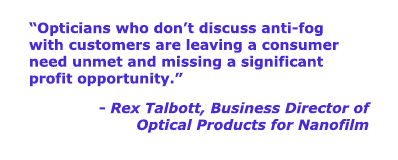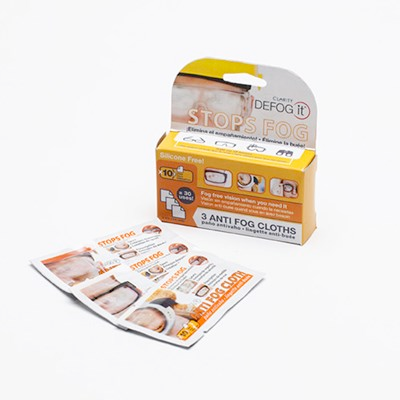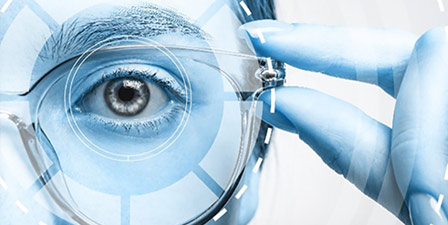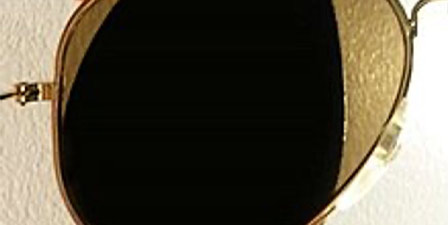You open the oven door to check your pizza, your glasses fog up. You’re speeding down a ski slope, your glasses and your goggles fog up. You step out of an air-conditioned car into the summer swelter, your sunglasses fog up.
You’re not alone. Nearly 50% of eyeglass wearers report fogging problems, according to a 2011 study by KRC Research. That means almost 50% of the customers who walk into your store have a fogging problem—winter, summer, every day of the year.
At worst it’s a safety issue – you don’t see debris on the ski slope or you burn yourself on the oven rack. At best it’s an annoyance – and a preventable one at that.
Clearing up a widespread fogging problem for their customers? Seems like a job for ECPs.

So, what is fog anyway?
So, how can the latest technologies help come up with a good anti-fog treatment? First let's ask what fog is and why does it seem to appear out of nowhere to sit on our eyeglasses.
Fog is made up of the water molecules that are already flying about in the air all around us—what we call humidity. Water molecules have a molecular affinity for each other. Think of them like a pile of magnets–that tends to make them stick together. Like magnets, water molecules pile up because they have positively charged regions and negatively charged regions. The positive parts of one molecule electrically attract the negative parts of the others, creating large clusters we see as fog.
What makes stopping fog so difficult?
If there are water molecules clustering in the air why don't we see fog all the time? Air currents knock the molecules apart before they can clump. Even when fog forms, it generally evaporates quickly.
But when the molecules strike a surface that is much colder than the ambient air—such as the eyeglass lenses of someone who just walked into the room from the cold—they slow down and stick together faster than currents blow them apart. You’ve got “magnetic attraction” creating watery fog.
The same thing happens more dramatically when an icy-cold drinking glass is taken out of the freezer. The glass quickly fogs because it cools the molecules in the surrounding air, allowing the water molecules in the air to condense—or clump—into beads. Those beads obscure the light and vision, which is not so bad on a glass of lemonade, but a real problem on eyeglasses.
High-performance anti-fog takes advanced science.
The job of anti-fog is to prevent the clumps of water, and there are several ways to accomplish that. Years ago, the best option was a thin coating of soap, which drives water molecules apart, making clumps less likely in the first place. The problem with this archaic method is it’s short-lived and may not work at all on today’s eyeglass lenses. Hydrophobic anti-reflective coatings make the surfaces “slick”, so the soaps don’t stick reliably. The result? A patchy, partially fogged appearance.
Scientists at Nanofilm have developed a completely different approach. Their Defog It anti-fog product coats the lens with a proprietary blend of surfactants not found in common soap substances that both strongly attract water and also grip tightly to all lens surfaces – even the slick hydrophobics. The effect? An invisible layer of molecular “moisture magnets” are firmly bonded all across a lens. Each water molecule is pulled to an anti-fog molecule and held tight in thin continuous sheet. No clumps form. No fog.
The science is proven in the lab and real life. In laboratory testing, a lens coated with Nanofilm’s Defog It anti-fog didn’t fog, even when held over hot steam for 60 minutes. The formula has been proven in mission-critical military settings and other harsh environments – from ski patrol professionals to utility plant workers to a national hunting organization.

The anti-fog sales opportunity is clear.
If 50% of customers are reporting a fog problem, how many sales are you missing a day?
Says Rex Talbott, Business Director of Optical Products for Nanofilm, “Opticians who don’t discuss anti-fog with customers are leaving a consumer need unmet, and missing a significant profit opportunity. For an additional $10-$20, depending on which product they buy, your consumer will benefit from being fog free and won't experience the annoyance of unclear vision. And for you, it helps build the dollar value of a sale.”

Talbott suggests a variety of customer lifestyle factors that should trigger an anti-fog purchase:
- Athletes and outdoor enthusiasts. Runners and cyclists, golfers and skiers, fishermen and hunters fight foggy glasses and sunglasses.
- Chefs and cooking fans. At home or at work, steaming pots and hot ovens cause fog.
- Delivery personnel. People moving frequently between indoors and outdoors.
- Youth athletes. If you’re dispensing Rec Specs or other prescription safety eyewear that’s required more and more in youth sports, anti-fog is truly a safety accessory.
- And ask about work settings. A number of customers may be in work situations where there is extreme heat or cold that fogs up their glasses – or safety goggles worn over them.
The technology of anti-fog treatment on eyeglasses has gone beyond home recipes, and customer expectations to the latest that technology has to offer.
Safety and comfort are possible – and in demand. Are you making the most of it?
For more information contact Lynn Lilly, [email protected], 216-702-5167
Dr. Stephanie Castro is Manager, Research and Development for Nanofilm, a leader in the lens coatings, lens treatments and lens cleaning products for 30 years. She has nearly a decade of experience developing advanced products for the precision optics market.
This article is sponsored by Nanofilm












